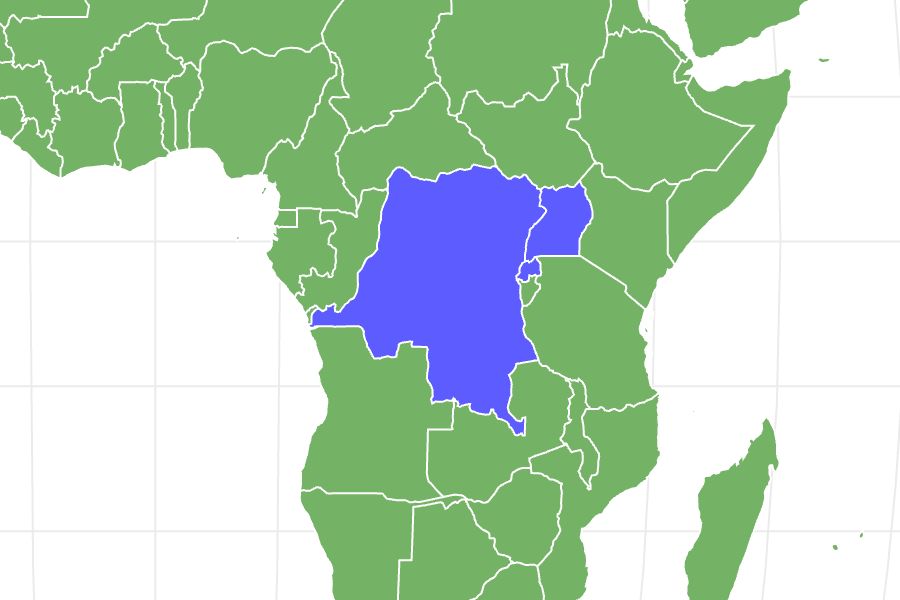Mountain Gorilla
Gorilla Berengei Berengei
Isolated populations found in the mountains!
Advertisement
Mountain Gorilla Scientific Classification
- Kingdom
- Animalia
- Phylum
- Chordata
- Class
- Mammalia
- Order
- Primates
- Family
- Hominidae
- Genus
- Gorilla
- Scientific Name
- Gorilla Berengei Berengei
Read our Complete Guide to Classification of Animals.
Mountain Gorilla Conservation Status
Mountain Gorilla Facts
- Main Prey
- Leaves, Seeds, Herbs
- Habitat
- Tropical forest and jungles in mountainous regions
- Predators
- Human, Leopard
- Diet
- Omnivore
- Average Litter Size
- 1
View all of the Mountain Gorilla images!
Big yet gentle, fierce yet compassionate, the mountain gorilla is an interesting contrast of extremes.
Deep within the cloud forests of central Africa, one of humanity’s closest living relatives lives peacefully among the trees. The mountain gorilla is a highly intelligent animal with a rich emotional and social life threatened by human encroachment and climate change. These giants of the forest offer insight into human evolution and astonish us with their ability to communicate – even learning sign language and developing large vocabularies when taught.

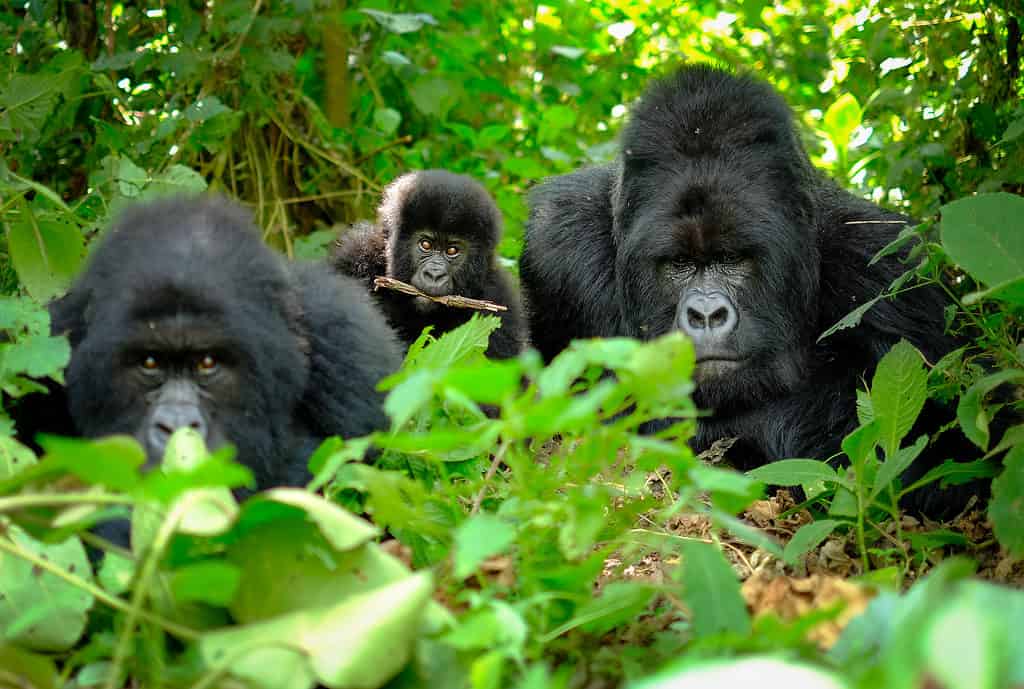
Gorillas are the biggest primates on earth and share 98.4% of their DNA with humans.
©Marian Galovic/Shutterstock.com
Facts About Mountain Gorillas
- Based on one metric of genome size, gorillas share around 98.4 percent of the same DNA as humans. This is only slightly lower than the 98.7 percent similarities between chimpanzees and humans.
- Individual mountain gorillas can be identified by the shape and patterns of their nose, just as humans can be identified by their fingerprints. No two gorillas share the exact same patterns.
- Due to the silver streak of hair along the backs of adult mountain gorillas, they are also commonly known as silverbacks.
- Baby mountain gorillas cling to their mother for the first two or three years of its life.
- Scent is an important aspect of gorilla communication. Smells can signal nearby threats from predators or the reproductive availability of females.
Scientific Name and Species

Skeletons of humans and gorillas illustrate commonalities between the two species.
©Cliff from Arlington, Virginia, USA, CC BY 2.0, via Wikimedia Commons – License
The scientific name of the mountain gorilla is Gorilla beringei beringei. It is actually one of two subspecies of the eastern gorilla — the other being the eastern lowland gorilla or Grauer’s gorilla. Although the same species, they are separated by geographical preferences and tend not to interbreed.
The closest related living species is the western gorilla. It was once classified as a third subspecies within the eastern gorilla group, but genetic analysis revealed enough of a difference to justify a separate species designation.
The mountain gorilla belongs to the same family, Hominidae, as the chimpanzees, orangutans, and humans, making it a somewhat distant cousin to us. Although it is difficult to give an exact date, the common ancestors of humans and gorillas appeared to have split around nine to ten million years ago. This is the approximate time when the gorilla and human evolutionary lineages diverged.
Evolution

was a genus of great apes that grew up to 3 meters high.
©Concavenator / CC BY-SA 4.0, , via Wikimedia Commons – License
According to fossil records, the apes of Hominidae appeared in Africa about 25 million years ago. The gibbon was the first ape to diverge around 18 million years ago. Gibbons and the great apes were already different animals than monkeys – primates that had kept their long tails.
The next ape to diverge was the orangutan around 14 million years ago. Apes were numerous in Africa during the late Miocene, 11 million years ago. The Gigantopithecus was a genus of great apes that grew up to 3 meters high. Many believe Gigantopithecus to be the ancestor of gorillas but it has not been proven. At this point, humans, Chimpanzees, and gorillas shared a common lineage that did not include orangutans.
Gorillas diverged from the other hominids about 11 – 7 million years ago. As other great apes became extinct – gorillas became the largest primate on earth.
Appearance
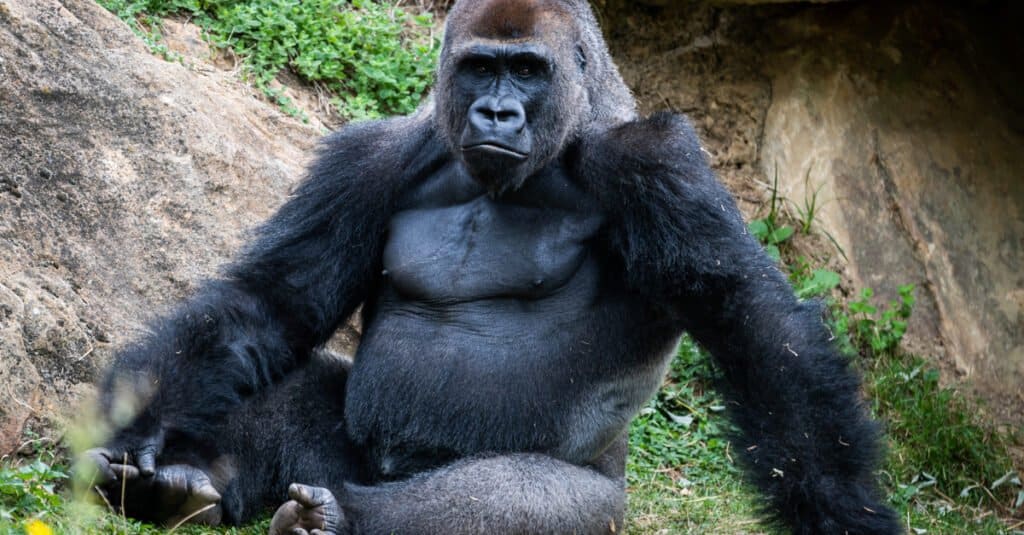
Mountain gorillas can grow to six feet tall and weigh up to 500 pounds.
©AB Photographie/Shutterstock.com
The mountain gorilla is a big, burly primate with long arms, a flat nose, an elongated, almost cone-shaped head, and a big, swollen belly. Its hair is almost completely black or brownish in color, but older males also have a silver or white streak running along the back. The feet, hands, face, and breasts are completely bald.
Compared to the closely related eastern lowland subspecies, the mountain gorilla has longer hair, shorter arms, and a bigger physique. This enables them to live in colder conditions that sometimes drop below freezing at night.
The typical mountain gorilla is around four to six feet tall when standing on its two legs. This is about the size of a typical person. However, due to their massive bulk, they can weigh 300 to 500 pounds. A male gorilla is typically larger than a female and weighs up to twice as much. Altogether, the mountain gorilla is the second-largest primate in the world, behind only the closely related eastern lowland gorilla.
Behavior
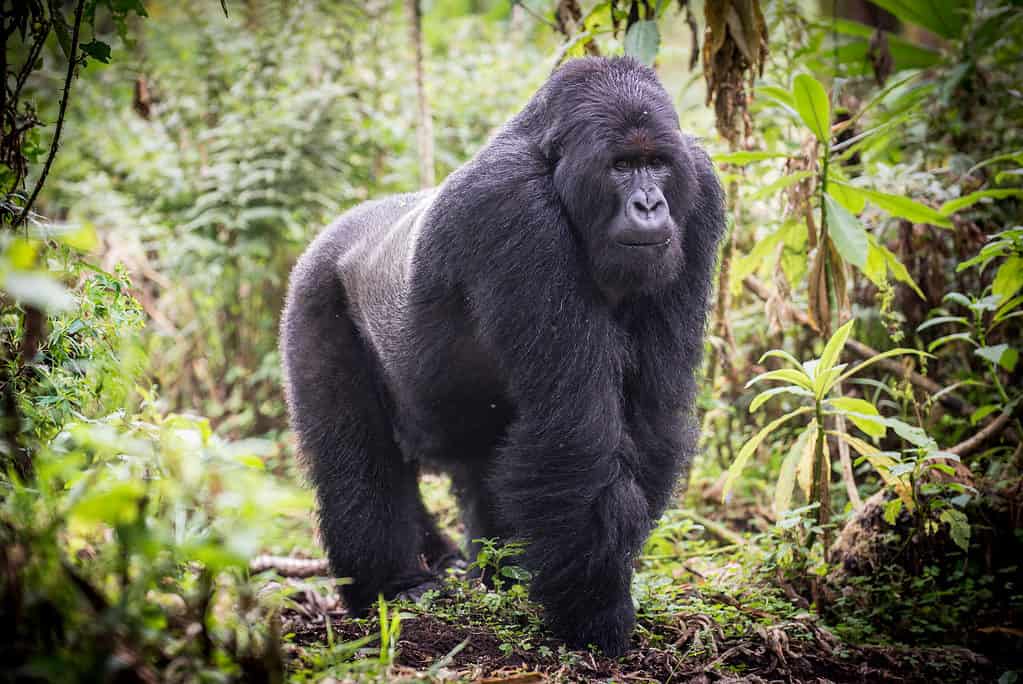
Gorillas travel by knuckle-walking but are also capable of walking on two legs for a short time.
©Jurgen Vogt/Shutterstock.com
The mountain gorilla has a unique method of locomotion known as knuckle-walking. This means that it walks around on all four limbs with its knuckles curled up on the ground. However, it is also capable of walking on two legs for a limited time. Its hands are very dexterous and capable of grasping, tearing, and pulling with precision only exceeded by human beings.
Like other great apes, the mountain gorilla is considered to be one of the most intelligent creatures on the planet. It is believed that they are capable of self-reflection, tool use, and careful planning. Intense studies of captive gorillas such as the well-known ‘Koko’ have revealed that individuals can understand and deploy sign language with some proficiency. They are also highly social creatures that can laugh, grieve, and develop strong attachments to others. Their social behavior is complex and sophisticated. Grooming is an important aspect of social bonding. Not only does it keep the gorillas free of dirt and parasites, but it also reinforces important relationships within the larger group.
Gorillas live in small groups called a troop that can sometimes exceed 20 individuals. These groups are composed of a single dominant male, a number of females, and young offspring. The dominant male is an older adult who provides organization and protection to all of the members. He has nearly exclusive breeding rights with the females. This breeding configuration is known as a harem. Sometimes a few younger males (usually the son or brothers of the leader) may accompany the group, but they are subservient to the dominant male. Subservient males are more likely to disperse from the troop if they cannot achieve reproductive success. They may go off on their own or form temporary all-male bachelor groups.
Gorillas have a rather calm and mellow personality most of the time, but if they perceive a threat, then the males can become quite aggressive by pounding the chest and making a terrifying roar. To convey their complex desires and emotions, mountain gorillas have around 25 different types of vocalizations, expressing everything from alarm to curiosity. And just like humans, body posture and eye contact help to facilitate communication.
The gorilla is a largely terrestrial creature that sticks to the land, but it does have a limited ability to climb into trees that will support its weight. Due to their smaller size, young gorillas are somewhat adept tree climbers. Both adults and children can sleep in nests on the ground or in the trees. The mountain gorilla is most active during the day and sleeps at night. It also has intermittent breaks during the day for rest and playtime. Altogether, the entire range of a single group can encompass up to 16 square miles.
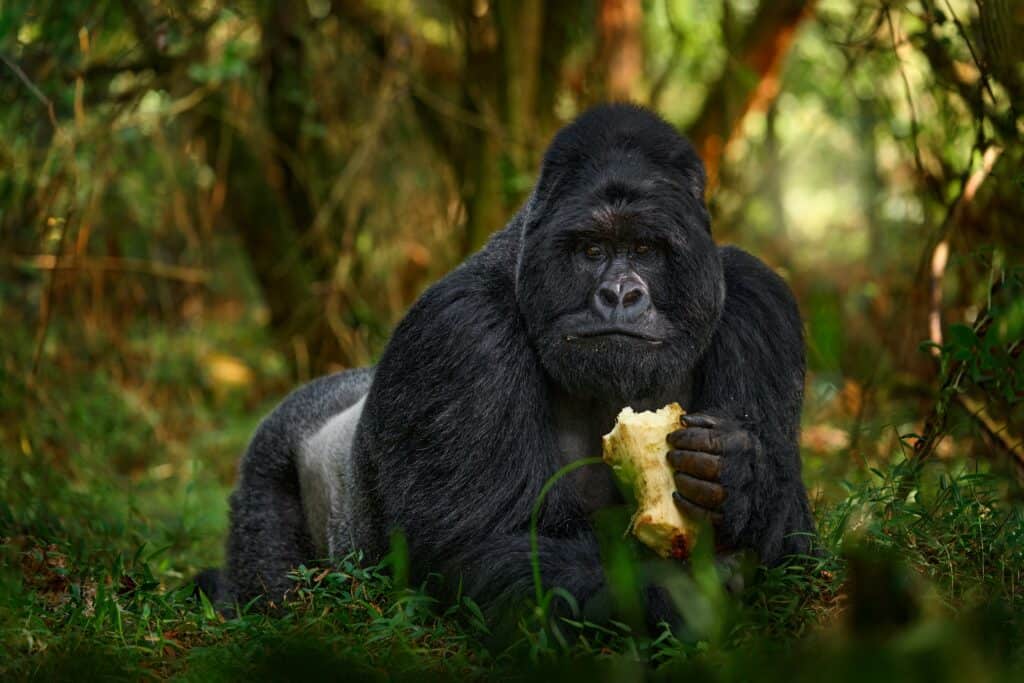
Mountain gorillas prefer mountain forest habitats between 8,000 and 13,000 feet up.
©Ondrej Prosicky/Shutterstock.com
Habitat
The mountain gorilla inhabits a very narrow range within central Africa. The main population centers are found in the Mgahinga Gorilla National Park and the Bwindi Impenetrable National Park in Uganda, as well as the Volcanoes National Park in Rwanda, and the Virunga National Park in the Democratic Republic of Congo. As the name implies, the subspecies prefer the forested regions of mountain habitats between 8,000 and 13,000 feet up. Their most common habitats include the rain forest, bamboo forest, subalpine grasslands, and mixed forests.
Diet
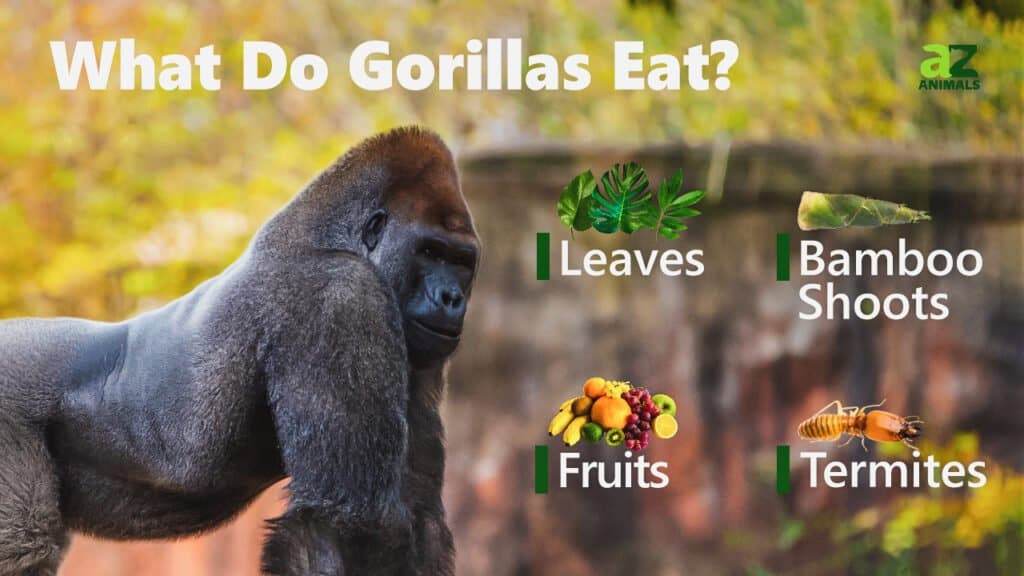
Mountain gorillas feast on several different tasty vegetation, including roots, fruit, flowers, leaves, and tree bark. Although largely herbivorous, they have been known to eat insects if no other food options are around. The exact dietary composition depends on the variety of local plants and trees available.
The gorillas spend around a quarter of their day munching on up to 75 pounds of food. With their long intestines and unique molars, they are specially adapted for eating and breaking down plant matter. Gorillas also play an important part in dispersing seeds around the environment.
Predators and Threats
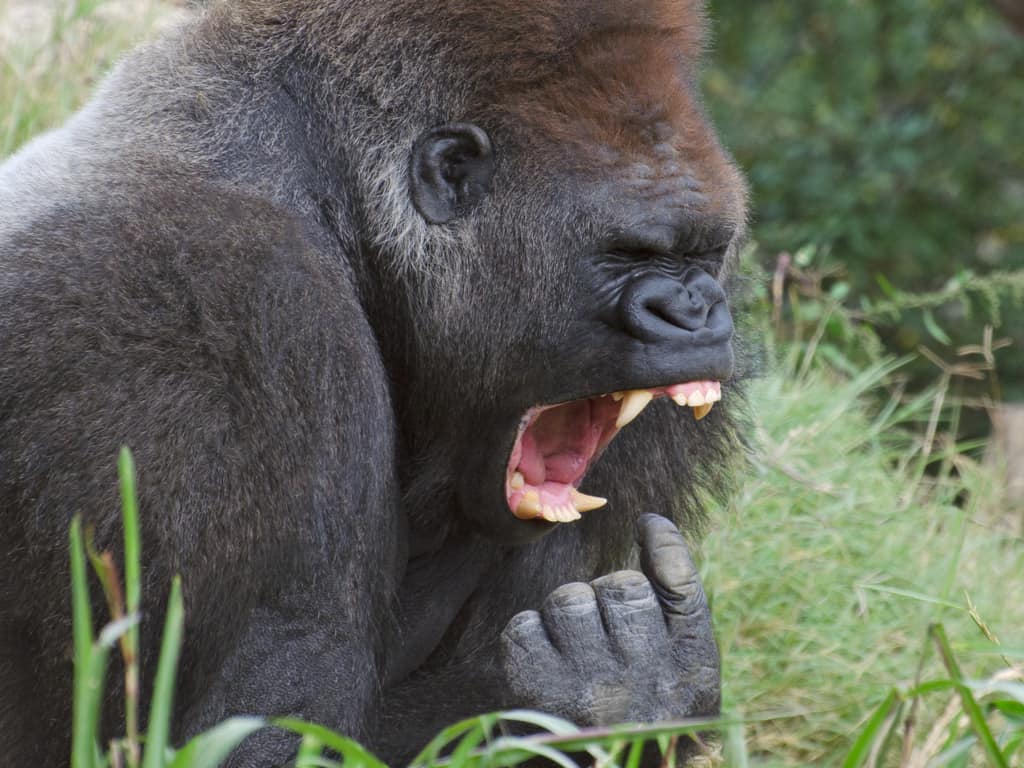
With few natural predators in the wild – humans are the greatest threat to the mountain gorilla.
©BDMPhoto/Shutterstock.com
Mountain gorillas, living under the protection of the troop, have few natural predators in the wild. Lone gorillas face the possibility of becoming prey for animals such as leopards and crocodiles if they become separated from the group.
With few natural predators, the greatest threat to their survival has been human activity, including warfare, illegal hunting, and habitat loss from mining, agriculture, and industry. A type of agricultural practice known as slash and burn, in which farmers clear land by burning away the vegetation, is particularly detrimental to the mountain gorilla’s habitat. And because humans and gorillas are so similar, it is not uncommon for diseases to make the leap between species during moments of close contact. Climate change will further exacerbate the threat of a changing environment to which the gorilla will need to adapt.
Due to the fragile social organization of the mountain gorillas, the death of the leading male can have a profound effect on the group and unravel the entire social structure. If there is no suitable replacement for a leader immediately available, then the group may split apart permanently.
Reproduction, Babies, and Lifespan
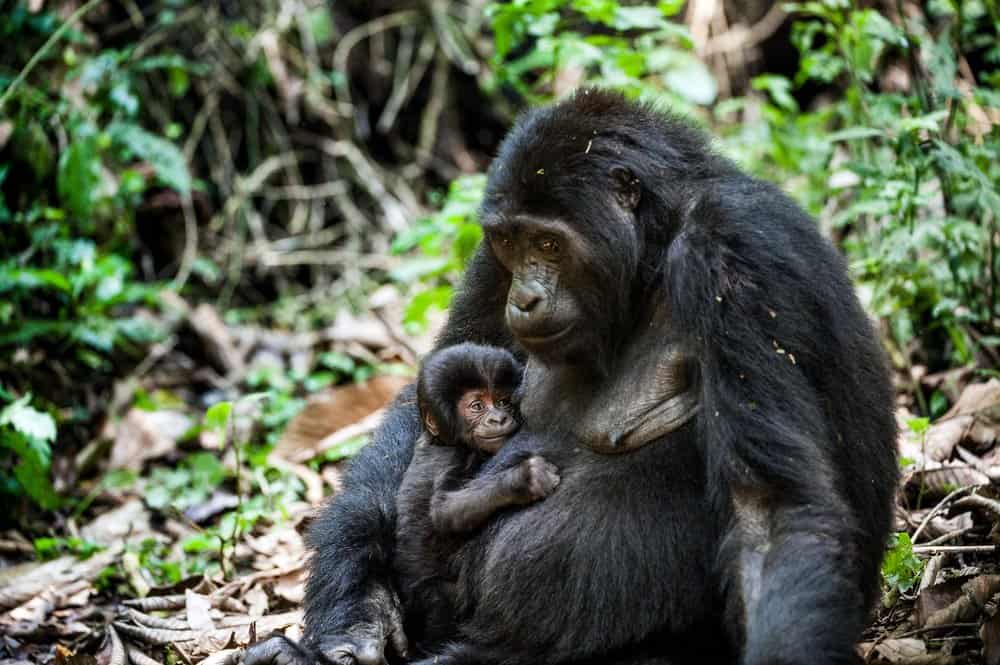
Female mountain gorillas can only give birth once every few years.
©Sergey Uryadnikov/Shutterstock.com
Gorilla reproduction shares many aspects in common with human reproduction. Females have the same nine-month gestation period. They tend to only give birth to a single infant at a time. And they can mate all year round rather than one specific season. However, unlike humans, gorillas can only give birth once every several years due to the longer development times of the offspring and the stress on the mother’s body.
Compared to a more mature gorilla, the newborn is surprisingly minuscule. It only weighs about four pounds out of the womb. From the moment of its birth, a newborn is almost inseparable from its mother, to whom it will cling for the first two or three years of its life. That is also about how long it takes to fully wean the child as well.
For most of its remaining adolescence, a gorilla will begin to learn valuable communication and social skills through frequent playtime such as chasing and wrestling. Nursing and caretaking are the primary responsibility of the mother, but the entire troop shares an interest in raising the child.
Male gorillas start out their adult lives with pure black hair. This characteristic has earned them the name blackbacks. However, they tend to develop a silver streak of hair on their back and hips at around 12 years old. These males are known as silverbacks. They are very protective of their own reproductive success. If a female and her infant join a new group, then the dominant male may kill the child in order to induce the female to breed again, so he can start producing his own children.
It typically takes at least a decade before an individual will reach full sexual maturity. In total, the mountain gorilla can live around 35 years in the wild, but lifespans up to 50 years old have been documented.
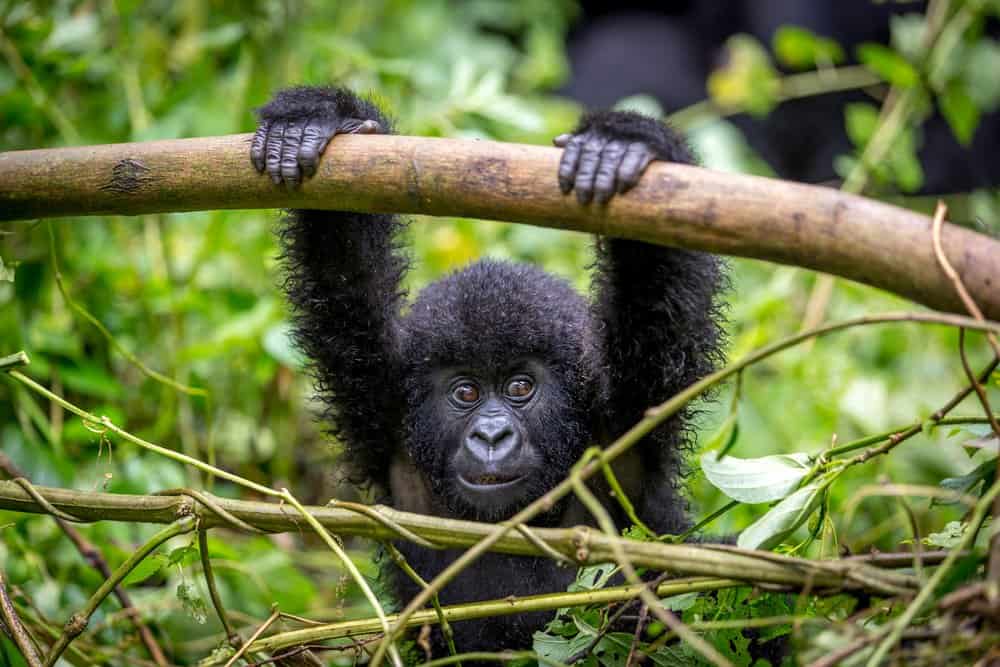
Mountain gorillas weigh around four pounds at birth and are totally dependent on their mothers.
©LMspencer/Shutterstock.com
Population
Mountain gorillas were once somewhat widespread across the mountains of central Africa, but population numbers have fallen precipitously since the 20th century. There are approximately a thousand mountain gorillas left in the world (and around 5,000 total members of the eastern gorilla species). Half of them live in the forests of the Virunga.
Thanks to careful conservation efforts, mountain gorilla numbers have shown signs of improving after the numbers fell to critically endangered levels. The International Union for the Conservation of Nature (IUCN) Red List now lists them as just endangered. However, they remain at constant risk of losing ground to the encroaching threats. Learn more about the most endangered species in the world here.
A more stable political climate in the region would dramatically improve the prospects for the long-term survival of the subspecies — and so would attempts to stop human encroachment and poaching in the region. African governments have begun to take a more active role in the preservation of their native species, giving them hope for a possible future.
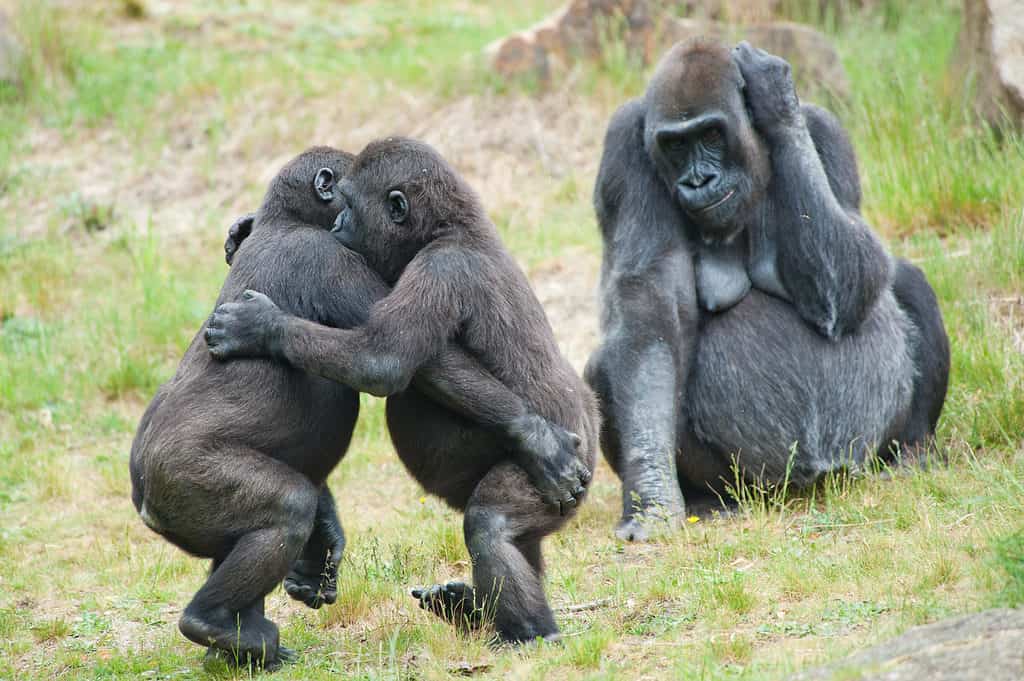
Gorillas live in extended family groups and remain in their mother’s care for at least three years.
©Eric Gevaert/Shutterstock.com
Mountain Gorilla FAQs (Frequently Asked Questions)
Where do mountain gorillas live?
Mountain gorillas are specifically adapted for the colder and highly elevated mountain regions of Africa.
Why is the mountain gorilla endangered?
Human activity — both intended to harm gorillas (poaching) and not specifically intended to harm (agriculture) — has significantly reduced mountain gorilla populations to a limited range.
What does a mountain gorilla eat - are they carnivores, herbivores, or omnivores?
The gorilla’s diet consists almost entirely of plant matter that is abundant around its habitat. It is mostly considered a herbivore, since very rarely will it resort to insects and meat.
How much does a mountain gorilla weigh?
An adult mountain gorilla can weigh anywhere between 200 pounds for a small female and 500 pounds for a large male. The largest recorded mountain gorilla has even exceeded 550 pounds.
How many mountain gorillas are left in the wild?
Current estimates suggest that there are slightly more than a thousand mountain gorillas left, clustered around small populations in a narrow mountainous range. The numbers are increasing, but the gorilla’s long adolescent phase and infrequent births make recovery slow.
What Kingdom do Mountain Gorillas belong to?
Mountain Gorillas belong to the Kingdom Animalia.
What phylum do Mountain Gorillas belong to?
Mountain Gorillas belong to the phylum Chordata.
What class do Mountain Gorillas belong to?
Mountain Gorillas belong to the class Mammalia.
What family do Mountain Gorillas belong to?
Mountain Gorillas belong to the family Hominidae.
What order do Mountain Gorillas belong to?
Mountain Gorillas belong to the order Primates.
What genus do Mountain Gorillas belong to?
Mountain Gorillas belong to the genus Gorilla.
What type of covering do Mountain Gorillas have?
Mountain Gorillas are covered in Hair.
What are some predators of Mountain Gorillas?
Predators of Mountain Gorillas include humans and leopards.
What is the average litter size for a Mountain Gorilla?
The average litter size for a Mountain Gorilla is 1.
What is an interesting fact about Mountain Gorillas?
Isolated populations of Mountain Gorillas are found in the mountains!
What is the scientific name for the Mountain Gorilla?
The scientific name for the Mountain Gorilla is Gorilla Berengei Berengei.
What is the lifespan of a Mountain Gorilla?
Mountain Gorillas can live for 35 to 50 years.
How fast is a Mountain Gorilla?
A Mountain Gorilla can travel at speeds of up to 25 miles per hour.
Thank you for reading! Have some feedback for us? Contact the AZ Animals editorial team.
Sources
- David Burnie, Dorling Kindersley (2011) Animal, The Definitive Visual Guide To The World's Wildlife
- Tom Jackson, Lorenz Books (2007) The World Encyclopedia Of Animals
- David Burnie, Kingfisher (2011) The Kingfisher Animal Encyclopedia
- Richard Mackay, University of California Press (2009) The Atlas Of Endangered Species
- David Burnie, Dorling Kindersley (2008) Illustrated Encyclopedia Of Animals
- Dorling Kindersley (2006) Dorling Kindersley Encyclopedia Of Animals
- David W. Macdonald, Oxford University Press (2010) The Encyclopedia Of Mammals

